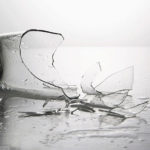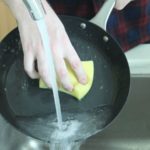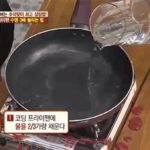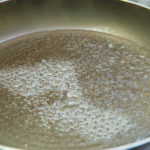It is a common habit for many people to immediately wash their pans after cooking. However, this practice can significantly impact the lifespan of your non-stick cookware. Read on to discover why you should avoid washing your pan right after cooking and learn some tips to maintain its non-stick surface.
1 Why You Shouldn’t Wash Your Non-Stick Pan Right After Cooking
 Washing the pan right after cooking can cause the non-stick coating to peel
Washing the pan right after cooking can cause the non-stick coating to peel
When you pour cold water into a hot pan, it experiences thermal shock, which can cause it to warp. The pan’s lifespan is reduced if this occurs repeatedly.
Additionally, the pan’s construction comprises multiple non-stick layers. When you pour cold water into a hot pan, the molecules in the pan’s layers expand and contract unevenly, with the upper metal layer expanding while the non-stick layer contracts.
As a result, the non-stick coating may peel, causing a loss of its non-stick properties, uneven heat distribution, and difficult cleaning due to food adhesion. Food debris from the non-stick coating may also contaminate your food, potentially leading to health issues. For these reasons, it is best to wait until the pan has cooled down before cleaning it.
2 How to Protect the Non-Stick Coating of Your Pan
 Tips to protect the non-stick coating of your pan
Tips to protect the non-stick coating of your pan
– For a new pan, use a soft cloth and < to clean it. After 10-12 uses, re-season the pan by applying a layer of coffee powder and heating it.
– Avoid adding or directly to a hot pan as it can cause the non-stick surface to pit.
– Refrain from using metal or sharp utensils on the pan’s surface.
– Clean with a soft, non-metallic scrubber.
– Do not place other cookware on top of the non-stick pan.
– Even with proper care, the non-stick coating of a high-quality pan typically lasts around three years. For health and safety reasons, consider replacing your non-stick pan after this period.
Now you know why you shouldn’t wash your non-stick pan immediately after cooking. We hope these tips help you maintain your non-stick cookware for a longer lifespan!
Why Does the Bottom of My Pan Bulge? Easy and Effective Methods to Fix It.
In conclusion, a pan with a bulging bottom is a common annoyance, but it doesn’t have to be a permanent problem. With a little bit of effort and the right technique, you can effectively fix your pan and get back to cooking without any worries. So why not give it a try and see the difference it can make in your kitchen?
What Should You Do With a New Frying Pan? Tips to Prolong the Lifespan of Non-Stick Coating.
Introducing the ultimate guide to caring for your new pan: “New Pan, New Rules: Unlocking the Secrets to Long-Lasting Non-Stick Success.”
The key to unlocking the full potential of your new pan lies in understanding the do’s and don’ts of its care. With the right knowledge, you can ensure the longevity of its non-stick capabilities and elevate your cooking experiences to new heights.
Let’s embark on a journey to discover the tips and tricks that will revolutionize the way you use your pan, ensuring it becomes a trusted companion in your culinary adventures.





































